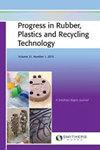玄武岩和聚丙烯纤维对硅酸盐水泥和铝酸钙水泥粘结剂橡胶砂浆的影响:强度和人工神经网络预测模型
IF 1.6
4区 材料科学
Q4 MATERIALS SCIENCE, COMPOSITES
Progress in Rubber Plastics and Recycling Technology
Pub Date : 2021-12-22
DOI:10.1177/14777606211062912
引用次数: 2
摘要
本文旨在研究玄武岩纤维(BF)和聚丙烯纤维(PPF)在普通硅酸盐水泥(OPC)和铝酸钙水泥(CAC)两种不同类型水泥中对碎胶砂浆(CR)性能的影响。CR在OPC和CAC砂浆中部分(按体积计5%、10%、15%和20%)替代细骨料。在CR砂浆中分别添加BF、PPF(按总体积比例分别为0.1%、0.3%和0.5%)。研究了水泥砂浆的稠度、密度、抗压强度和抗弯强度。使用CAC水泥后,稠度略有提高;结果表明,CR的替代和两种纤维的加入都有降低OPC和CAC砂浆稠度的趋势。随着CR含量的增加,纤维掺入CR砂浆的密度显著降低,而PPF和BF的影响都很小。随着CR含量和纤维含量的增加,粘结剂和纤维类型的掺纤维CR砂浆的28 d抗压强度总体呈降低趋势。然而,在添加0.1%的两种纤维时,发现含有20% CR的CAC砂浆的抗压强度增强。CR的使用和纤维的加入普遍降低了两种粘结剂砂浆的抗弯强度;然而,在含有15-20% CR的砂浆中添加0.3% BF对抗弯性能有积极影响。最后,人工神经网络(ANN)方法对添加纤维CR砂浆的抗压强度进行了预测。模型均方误差(MSE)为1.4 ~ 1.5,高图回归(R)结果为0.97 ~ 0.98。本文章由计算机程序翻译,如有差异,请以英文原文为准。
Effect of basalt and polypropylene fibers on crumb rubber mortar with Portland cement and calcium aluminate cement binders: Strength and artificial neural network prediction model
This paper aims to study the influence of basalt fiber (BF) and polypropylene fiber (PPF) in crumb rubber (CR) mortar made of two different types of cement, including ordinary Portland cement (OPC) and calcium aluminate cement (CAC). CR was used to partially (5%, 10%, 15%, and 20% by volume) replace the fine aggregate in OPC and CAC mortars. BF and PPF were added (0.1%, 0.3%, and 0.5% by total volume) in the CR mortars. The consistency, density, compressive, and flexural strength of cement mortars were investigated. The use of CAC cement slightly increased the consistency; however, the results showed that the CR replacement and the addition of both fiber types tend to reduce the consistency in OPC and CAC mortars. Significant reduction in the density of fiber-added CR mortar was found with increasing CR content, whereas the influence of both PPF and BF was minimal. The fiber-added CR mortar made of both binder and fiber types in general exhibited a reducing trend in the 28 days compressive strength when increasing CR and fiber contents. Nevertheless, an enhancement in the compressive strength of CAC mortar with 20% CR was found with the addition of 0.1% of both fibers. The use of CR and addition of the fibers generally decreased the flexural strength of mortar made of both binder types; however, the addition of 0.3% BF in mortars containing 15–20% CR positively affected the flexural performance. Finally, the artificial neural network (ANN) approach demonstrated the ability to predict the compressive strength of fiber-added CR mortars. The model showed a considerably insignificant mean square error (MSE) of 1.4–1.5 and high plot regression (R) results of 0.97–0.98.
求助全文
通过发布文献求助,成功后即可免费获取论文全文。
去求助
来源期刊

Progress in Rubber Plastics and Recycling Technology
MATERIALS SCIENCE, COMPOSITES-POLYMER SCIENCE
CiteScore
4.40
自引率
7.70%
发文量
18
审稿时长
>12 weeks
期刊介绍:
The journal aims to bridge the gap between research and development and the practical and commercial applications of polymers in a wide range of uses. Current developments and likely future trends are reviewed across key areas of the polymer industry, together with existing and potential opportunities for the innovative use of plastic and rubber products.
 求助内容:
求助内容: 应助结果提醒方式:
应助结果提醒方式:


